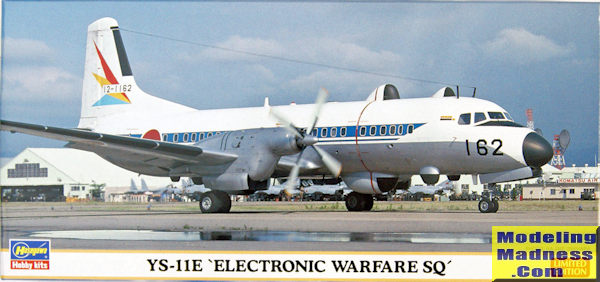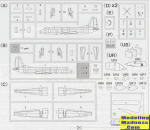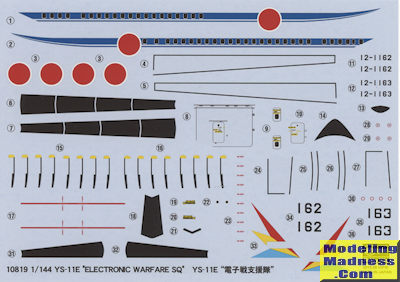
Hasegawa 1/144 YS-11E "Electronic Warfare Squadron"
| KIT #: | 10819 |
| PRICE: | 2560 yen (about $25) from www.hlj.com |
| DECALS: | None |
| REVIEWER: | Scott Van Aken |
| NOTES: | 2016 Limited Edition. Includes resin parts |

| HISTORY |
The first production YS-11 flew on October 23, 1964 and was delivered on March 30, 1965, with initial airline operations by Toa Airways beginning in April 1965. At first, deliveries were mainly to Japanese airlines, and NAMC developed the YS-11A, with higher gross weight, to make the aircraft more attractive to the North American market, and in particular to meet the requirements of Piedmont Airlines, which ordered ten YS-11A-200s, with an option for an additional ten aircraft. Orders slowed after the needs of the Japanese commuter airlines for which it had been designed were met. This, together with losses growing to $600 million, resulted in production being stopped after completion of 182 aircraft, with the last YS-11 being delivered to the Japanese Maritime Self-Defence Force on May 11, 1973.
The YS-11 was slowly phased out by airlines in Japan due to new directives issued by the Ministry of Land, Infrastructure, Transport and Tourism requiring all commercial aircraft in Japan to be fitted with a Traffic Collision Avoidance System (TCAS). Aircraft without TCAS were forced to cease operations at the end of 2006. Since equipping a YS-11 with TCAS would have cost ¥100 million (about US$1 million), a refit was deemed economically unsound. Aircraft still in flying condition were sold to foreign companies. On September 30, 2006, Japan Air Commuter Flight 3806 marked the final flight for a YS-11 in Japan's commercial aviation industry. In 2007, the YS-11 was added to the Mechanical Engineering Heritage of Japan as item number 13. As of 2014, 15 are operated by the Japanese military, and two in Mexico.
The versions supplied to the Japanese military are the 'Super YS' with uprated engines. Current planes are in a very boring two color grey scheme. These aircraft replaced the EC-46s that were used for the same task.
| THE KIT |
 This
is one of those kits that often flies under the radar of most modelers, and it
is a shame as it builds into an excellent model. I've built the ANA airliner
version and found it to be well thought out. This one is a special boxing that
includes not only weights for the nose, but also several new pieces produced in
resin for all the various lumps and bumps that festoon this particular variant.
This
is one of those kits that often flies under the radar of most modelers, and it
is a shame as it builds into an excellent model. I've built the ANA airliner
version and found it to be well thought out. This one is a special boxing that
includes not only weights for the nose, but also several new pieces produced in
resin for all the various lumps and bumps that festoon this particular variant.
Unlike many kits, this one comes with a display stand, for which a hole will need to be opened in the fuselage halves prior to construction. Also one will need to cut away the various antennas already molded on the fuselage that are not pertinent to this version. There is a cockpit of sort with simply some seats molded to a forward section. It is to the back of this section that the weights are attached in a small cage made specifically for this purpose. There are no windows molded on the fuselage to allow the kit to be used for a variety of airlines and military liveries.
Engines are each three pieces and hold poly-caps for the props. Wings are an upper and lower section on each sied and include a rudimentary wheel well. The engine nacelles simply slide onto the front of the wing. Once the wings and the tail planes are attached to the fuselage, it is time to start attaching resin bits. These are all over the upper and lower as well as the side of the fuselage and the instructions show exactly where each one fits.
 One can
build the airplane in flight and separate closed gear door assemblies are
provided for this. Those wishing the plane on its wheels have nicely molded gear
on which to place the airplane. The last thing one does is insert the windscreen
and the props.
One can
build the airplane in flight and separate closed gear door assemblies are
provided for this. Those wishing the plane on its wheels have nicely molded gear
on which to place the airplane. The last thing one does is insert the windscreen
and the props.
Instructions have detailed notes regarding the mods and placement of the resin bits. There is the usual Gunze paint reference and two markings options are provided. These differ only in the serial number and in the way the nose radome is painted. The decal sheet includes wing walk markings, de-icing boots and even prop decals. It is superbly printed and should work as well as any aftermarket sheet. This boxing is of the plane when it was still in its bright livery with the colorful tail markings.
| CONCLUSIONS |
If you haven't figured it out already, this is a very nice little kit. The resulting model is a fairly good size and thanks to the colorful markings, will make a nice addition to your display area.
| REFERENCES |
https://en.wikipedia.org/wiki/NAMC_YS-11
October 2016 Copyright ModelingMadness.com Thanks to www.hlj.com for
the preview kit. Get yours at
this link. If you would like your product reviewed fairly and fairly quickly, please contact the editor or see other details in the
Note to
Contributors.